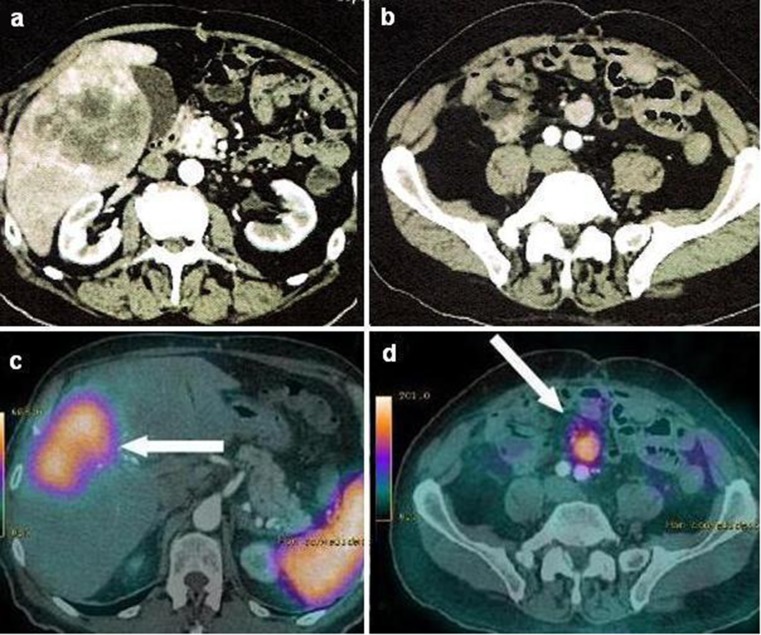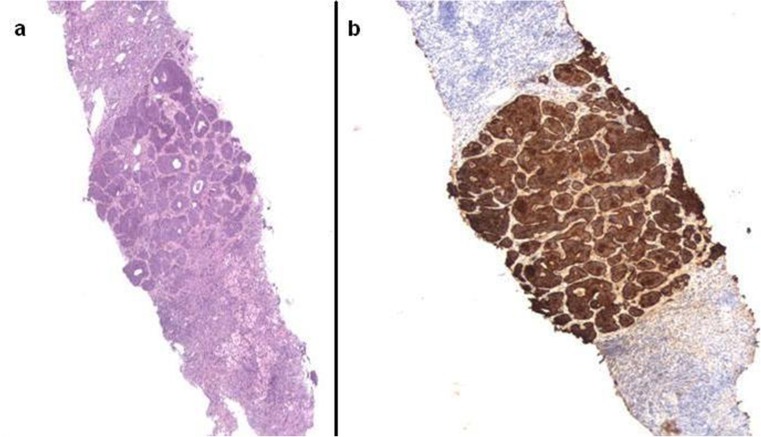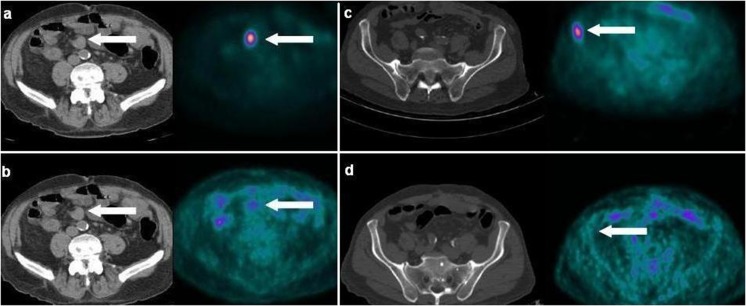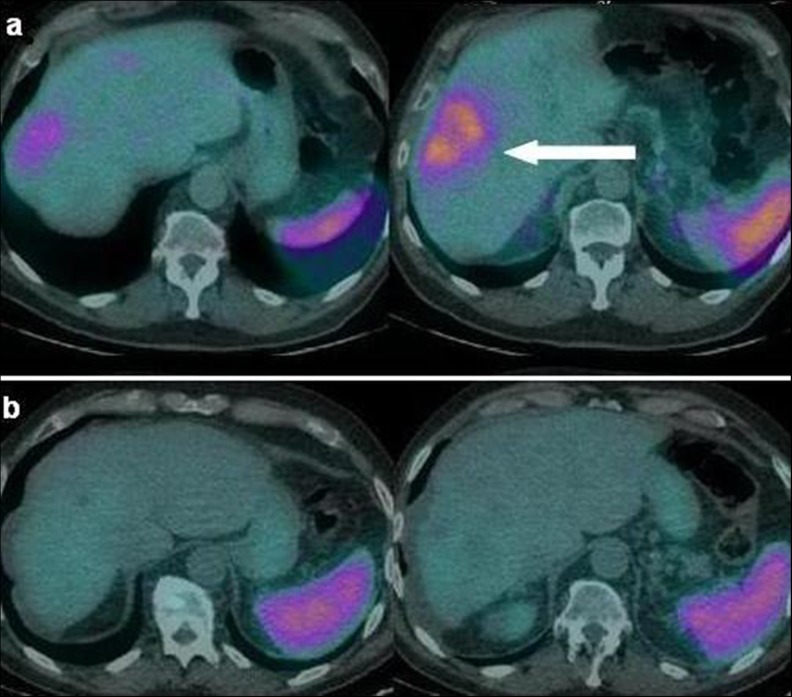Abstract
90Y radioembolization and peptide-receptor radionuclide therapy (PRRT) with177Lu-DOTATATE are both effective treatments for patients with inoperable neuroendocrine metastatic tumors (NET). We report the case of a 72-year-old man with severe functional syndrome due to a metastatic NET. 68Ga-DOTATOC positron-emission tomography (PET) revealed high somatostatin receptor expression in a gross liver metastasis, in one abdominal lymph node and in several skeletal lesions. The patient underwent liver radioembolization with 90Y-resin microspheres followed by four cycles of PRRT with177Lu-DOTATATE. After 3 months, a complete remission of the functional syndrome was observed. 68Ga-DOTATOC PET demonstrated a complete response for skeletal and lymph nodal lesions with a residual bulky mass in the liver. Therefore a further 90Y radioembolization was performed as consolidation treatment for the hepatic lesion. Six months after these combined treatments, 68Ga-DOTATOC PET demonstrated complete metabolic response in liver and stable extrahepatic lesions. No significant long-term adverse reactions were registered. To our knowledge, the sequential use of 90Y radiembolization before and after PRRT in a liver-dominant advanced NET has not been reported in the literature and this case suggests that these combined treatments can be safe and effective.
Keywords: 90Y radioembolization, 177Lu DOTATATE, Neuroendocrine tumors, Somatostatin receptors
Introduction
Neuroendocrine tumors (NETs) represent a heterogeneous group of tumors, arising from neuroendocrine cells of the digestive and respiratory tracts, with distinct morphological and biological manifestations [1]. They have a propensity to become clinically evident due to functional syndromes caused by specific secreted neuropeptides. Liver is a site of a frequent colonization for NET.
Survival and quality of life for patients affected by NET strictly depend on the suppression of the functional syndrome and the control of tumor growth. Several therapeutic approaches have been introduced to manage NET [2]. In case of liver metastases, transarterial chemoembolization can be useful but its effects are usually of short duration [3]. Somatostatin analogues can be useful to mitigate functional syndromes, but it is still debated whether or not they can improve the survival.
Several reports demonstrated that peptide-receptor radionuclide therapy (PRRT) with 90Y- or 177Lu-labeled octreotide analogues can achieve good therapeutic results in NET [4]. However, PRRT can present some limitations in treating bulky hepatic lesions. The biodistribution of labeled octreotide analogue, in fact, includes marked renal uptake and clearance; therefore, around 30 % of the injected activity is lost in the urine within the first few hours and does not contribute to the therapy. McStay et al. [5] injected 90Y-labeled lanreotide directly to the NET bulky hepatic metastasis by means of hepatic intra-arterial infusion in order to achieve high intra-tumoral concentration of the compound.
Selective internal radiation therapy (SIRT) with 90Y microspheres can be used to deliver radiation directly to liver tumors. It has been successfully applied to treat NET liver metastases with relatively long-term responses [6].
In this paper, we present the clinico-pathologic and imaging findings in a case of advanced pluri-metastatic NET, which was treated with the sequential use of 90Y-microsphere radioembolization before and after [177Lu-DOTA0-Tyr3]-Octreotate (DOTATATE) PRRT.
Case Report
A 72-year-old man presented at the Department of Internal Medicine of our hospital, complaining of diarrhea, cutaneous flushing and 3-kg weight loss for 4 months. Past medical history included emergency surgery for a stenosing terminal ileal tumor 10 years before, whose histology was positive for a neuroendocrine well-differentiated tumor. The patient had not received chemotherapy and the follow-up was negative for the years after surgery. The patient worked as a teacher for several years. He denied alcohol, drug use, and smoking.
On admission, the patient had a complete laboratory workup involving all systems. The abnormalities found were in the levels of γ-glutamyl transferase (91 U/l; normal range, 0–50), total bilirubin (1.5 mg/dl; normal range, 0.3–1.0), direct bilirubin (0.7 mg/dl; normal range, 0.0–0.2), creatinine (1.45 mg/dl; normal range, 0.7–1.3). Abdominal ultrasound examination revealed a gross hypoechoic mass with hyperechoic halo in the right lobe of the liver. The patient was submitted to contrast-enhanced computed tomography (CT), which revealed a bulky lesion in the VIII–IV hepatic segments (Fig. 1a) with a smaller localization in the VI hepatic segment. Moreover, CT disclosed one lymph node in the mesenterial adipose tissue (Fig. 1b). All the lesions showed avid early enhancement at CT imaging, thus being highly suspicious for NET metastases.
Fig. 1.
Contrast-enhanced CT that revealed a bulky lesion in the VIII-IV hepatic segments (a) and in one nodulation in the mesenterial tissue, compatible with lymph node localization (b). 68Ga-DOTATOC positron-emission tomography (PET) demonstrated increased somatostatin receptor expression (subtype 2) within the hepatic (c, arrow) and lymph nodal lesions (d, arrow)
68Ga-DOTA-D-Phe1-Tyr3-Octreotide (DOTATOC) PET was performed, thus demonstrating increased somatostatin receptor expression (subtype 2) within the liver (Fig. 1c) and the mesenterial lymph node (Fig. 1b) with skeletal lesions. Therefore, biopsy of the hepatic lesion was obtained. Microscopic examination revealed well-differentiated metastasis from ileal tumor, strongly positive for chromogranin, neuron-specific-enolase and synaptophysin on immunohistochemical analysis (Fig. 2). Baseline chromogranin A (CgA) plasma levels were 878 U/l.
Fig. 2.
Hematoxylin/eosin, 4×. Hepatic metastasis of well-differentiated ileal neuroendocrine tumor (a). Immunohistochemical assay, 4×. The neoplastic cells are diffusely and strongly positive for chromogranin (b)
Therapy with lantreotide (60 mg every 28 days) was started in order to control the symptoms due to the functional syndrome. Furthermore, nuclear physicians in agreement with the oncologists took the collegial decision to delay further systemic therapy in favor of 90Y radioembolization for a downstaging of the liver lesion. Prior to receiving SIRT, pretreatment hepatic angiography, CT hepatic arteriography and a macroaggregated albumin scan through the indwelling catheter was performed to evaluate for liver-to-lung shunts and remaining vascular connections between the liver and gastrointestinal tract.
On the day of the treatment, the patient was administered with 1.7 GBq of microspheres (SIR-Spheres; Sirtex Medical, Sydney, Australia) without sedation by a slow, manually controlled injection lasting about 30 min, after selective catheterization of the right hepatic artery. The patient took lansoprazole, 30 mg twice daily, for 1 month following the procedure.
Contrast-enhanced CT at 3 months following radioembolization showed a mildly decreased hepatic tumor size with a significantly increased percentage of necrosis.
Since PET had demonstrated high expression of somatostatin receptor, our patient was submitted to PRRT, performed by the administration of a mean activity of 7.5 GBq of 177Lu-DOTATATE per treatment cycle, aimed at four courses at standard intervals of 3 months (10–14 weeks). Nephroprotection was implemented with standard amino acid coinfusion according to the Rotterdam protocol. Lantreotide was paused 4 weeks before PRRT.
Restaging was performed 3 months after PRRT by contrast-enhanced CT, 68Ga-DOTATOC PET and CgA levels measures. CT showed partial response for the liver mass (−30 % in size) and stability for the lymph node and the skeletal lesions. 68Ga-DOTATOC PET indicated an almost complete remission for the extrahepatic localizations (Fig. 3) and significant but incomplete regression of the hepatic tumor mass (Fig. 4a). The CgA levels were 276 U/l and complete remission of the functional syndrome was registered.
Fig. 3.
The unenhanced CT and PET corresponding images showed intense 68Ga-DOTATOC uptake in the mesenterial nodulation (a, arrow) before treatment. The unenhanced CT and PET slices demonstrated an almost complete remission of the lymph nodal localization (b, arrow) after PRRT. 68Ga-DOTATOC PET depicted a focal area of tracer accumulation in the right iliac bone (c, arrow). Complete remission of the skeletal lesion (d, arrow) after PRRT
Fig. 4.
68Ga-DOTATOC PET demonstrated residual tumoral mass (a, arrow) in the right lobe of the liver after one cycle of 90Y radioembolization followed by PRRT. After a further 90Y radiembolization, PET showed complete remission of the right lobe lesion (b). Note the compensatory hypertrophy of the left hepatic lobe and a minimal amount of peri-hepatic fluid that underwent to a complete resolution after steroid therapy
Due to the persistence of the hepatic bulky mass, a further 90Y radioembolization was performed as consolidation treatment. The procedure was performed as previously described and 1.4 GBq of microspheres was administered.
The total dosimetry delivered to the liver and non-targeted areas was calculated through 90Y PET-based dosimetry as previously described [7]: the median dose delivered to tumor was 97 Gy for the first treatment and 112 Gy for the second procedure, while the normal parenchyma received an average dose of 20 and 18 Gy, respectively, at the first and the second SIRT session.
The restaging, performed 6 months after these combined treatments were concluded, showed a complete remission of the liver metastasis at the 68Ga-DOTATOC PET (Fig. 4b) and stability for the other localizations. A minimal amount of peri-hepatic fluid was observed at the unenhanced CT co-registered with PET. Liver function laboratoristic tests were normal, thus a corticosteroid therapy was started with complete resolution of the ascites and a further decrease of CgA levels (i.e. 112 U/l).
The patient continued lantreotide and had complete laboratory workup every 4 weeks until 6 months after treatments and regular follow-up visits at 1, 3, 6, 12 months after the combined therapies. No significant adverse reaction were registered.
The overall survival assessed from the start of the treatments was 42 months with a complete symptomatic control of the functional syndrome.
Discussion
At present there are few reports regarding the sequential use of 90Y radioembolization and PRRT for the treatment of metastatic NET.
Radioembolization is known to be a useful tool in treating primary and secondary tumors of the liver [8]. In particular, several published papers reported that 90Y radioembolization can be effective and safe in hepatic NET [6].
King et al. [9] treated 34 patients affected by hepatic NET with 90Y radioembolization: symptomatic responses were registered in 50 % of the patients at 6 months post treatment, and the mean overall survival was 29.4 ± 3.4 months. Two patients had biopsy-proven radiation gastritis, one died due to liver dysfunction and pneumonia. In our patient, we observed mild nausea and lethargy that lasted only 2 weeks after radioembolization.
When extrahepatic NET metastases are also present, combined systemic and loco-regional therapies are mandatory. Radiolabeled somatostatin analogues, like 90Y-DOTATOC and 177Lu-DOTATATE, have been demonstrated to be effective for patients who have somatostatin receptor-positive NET. In particular, Paganelli et al. [10] reported 177Lu-DOTATATE to be an effective therapeutic tool in patients with advanced progressive NET, with a disease control rate of 84 % that lasted for 25 months and a progression-free survival of 36 months. Moreover, the authors indicated that both activities of 27.8 GBq and 18.5 GBq are safe and effective in all patients, including those with a higher probability of developing kidney or bone marrow toxicity. As regards the PRRT, our patient received a dosimetry-based cumulative dose of 30 GBq 177Lu-DOTATATE without significant bone marrow and kidney toxicity at follow-up. Our results are substantially in line with those of Delpassand et al. [11], indicating that treatment with multiple cycles of 177Lu-PRRT is well tolerated up to a cumulative dose of 29.6 GBq ± 10 %. However, it is still debated whether or not PRRT can be safely used in association with 90Y radioembolization.
One of the most important criteria of exclusion for 90Y radiembolization is represented by prior hepatic radiation exposure such as external-beam therapy. Vasamiliette et al. [12] described the case of a 39-year-old man affected by unresectable thymoma and synchronous liver metastases, showing enhanced somatostatin-receptor expression at 68Ga-DOTATOC PET, treated with 90Y-DOTATOC. Only the primary tumor responded to PRRT, thus liver metastases underwent 90Y radioembolization with good results. No significant toxicity was reported.
Ezzidin et al. [13] retrospectively assessed a consecutive cohort of 23 patients with hepatic NET undergoing 90Y radioembolization as salvage therapy after PRRT. One patient had gastroduodenal ulcer, while the remaining patients presented only mild, transient toxicity with an overall response rate for radiologic, biochemical and symptomatic response of 30.4, 53.8 and 80 % respectively. The authors concluded that 90Y radioembolization can be safe and effective also in patients with past history of PRRT. Worth of note, repeated 90Y radiembolization might lead to a higher risk of radiation-induced hepatic disease (REILD) due of the liver’s cumulative memory of previous exposure. Lam et al. [14] reported an elevated risk of REILD for repeated SIRT in eight patients receiving two consecutive procedures. However, the authors did not perform a voxel-based dosimetry on the targeted lesions and the normal parenchyma. In cases of repeated treatments, dosimetry is mandatory. Our patient received a cumulative dose to the normal liver of 38 Gy, still below the threshold of 43 Gy reported by Emami et al. [15].
The preferable treatment sequence (i.e. 90Y radioembolization before or after PRRT) is still a debated issue. In our patient, SIRT was applied before PRRT to downstage the gross hepatic lesion and also after PRRT as consolidation therapy for the liver residual disease. Our results suggest that 90Y radioembolization can be safely used in combination with PRRT, especially in case of liver-dominant tumor. Moreover, individualized and combined treatments, taking into account the tumor’s biological and clinical presentation, as well as the patient’s performance status and preference, seem to be the best therapeutic options for advanced NET.
Acknowledgements
All human and animal studies were approved by the appropriate ethics committee and were therefore performed in accordance with the ethical standards laid down in the 1964 Declaration of Helsinki and its later amendments.
Conflict of Interest
Luca Filippi, Alida Ciorra, Barbara Sardella, Orazio Schillaci, and Oreste Bagni declare no conflict of interest.
References
- 1.Modlin IM, Lye KD, Kidd M. A 5-decade analysis of 13,715 carcinoid tumors. Cancer. 2003;97(4):934–59. doi: 10.1002/cncr.11105. [DOI] [PubMed] [Google Scholar]
- 2.Basuroy R, Srirajaskanthan R, Ramage JK. A multimodal approach to the management of neuroendocrine tumour liver metastases. Int J Hepatol. 2012 doi: 10.1155/2012/819193. [DOI] [PMC free article] [PubMed] [Google Scholar]
- 3.O’Toole D, Ruszniewski P. Chemoembolization and other ablative therapies for liver metastases of gastrointestinal endocrine tumours. Best Pract Res Clin Gastroenterol. 2005;19(4):585–94. doi: 10.1016/j.bpg.2005.02.011. [DOI] [PubMed] [Google Scholar]
- 4.Van Essen M, Krenning EP, Kam BL, de Jong M, Valkema R, Kwekkeboom DJ. Peptide-receptor radionuclide therapy for endocrine tumors. Nat Rev Endocrinol. 2009;5(7):382–93. doi: 10.1038/nrendo.2009.105. [DOI] [PubMed] [Google Scholar]
- 5.McStay MK, Maudgil D, Williams M, Tibballs JM, Watkinson AF, Caplin ME, et al. Large-volume liver metastases from neuroendocrine tumors: hepatic intraarterial 90Y-DOTA-lanreotide as effective palliative therapy. Radiology. 2005;237:718–26. doi: 10.1148/radiol.2372041203. [DOI] [PubMed] [Google Scholar]
- 6.Rajekar H, Bogammana K, Stubbs RS. Selective internal radiation therapy for gastrointestinal neuroendocrine tumour liver metastases: a new and effective modality for treatment. Int J Hepatol. 2011;2011:404916. doi: 10.4061/2011/404916. [DOI] [PMC free article] [PubMed] [Google Scholar]
- 7.D’Arienzo M, Filippi L, Chiaramida P, Chiacchiararelli L, Cianni R, Salvatori R, et al. Absorbed dose to lesion and clinical outcome after liver radioembolization with 90Y microspheres: a case report of PET-based dosimetry. Ann Nucl Med. 2013;27:676–80. doi: 10.1007/s12149-013-0726-4. [DOI] [PubMed] [Google Scholar]
- 8.Cianni R, Pelle G, Notarianni E, et al. Radioembolisation with (90) Y-labelled resin microspheres in the treatment of liver metastasis from breast cancer. Eur Radiol. 2013;23(1):182–9. doi: 10.1007/s00330-012-2556-5. [DOI] [PubMed] [Google Scholar]
- 9.King J, Quinn R, Glenn DM, Janssen J, Tong D, Liaw W, et al. Radioembolization with selective internal radiation microspheres for neuroendocrine liver metastases. Cancer. 2008;113(5):921–9. doi: 10.1002/cncr.23685. [DOI] [PubMed] [Google Scholar]
- 10.Paganelli G, Sansovini M, Ambrosetti A, Severi S, Monti M, Scarpi E, et al. 177 Lu-Dota-octreotate radionuclide therapy of advanced gastrointestinal neuroendocrine tumors: results from a phase II study. Eur J Nucl Med Mol Imaging. 2014. doi:10.1007/s00259-014-2735-5. [DOI] [PubMed]
- 11.Delpassand ES, Samarghandi A, Zamanian S, Wolin EM, Hamiditabar M, Espenan GD, et al. Peptide receptor radionuclide therapy with 177Lu-DOTATATE for patients with somatostatin receptor-expressing neuroendocrine tumors: the first US phase 2 experience. Pancreas. 2014;43:518–25. doi: 10.1097/MPA.0000000000000113. [DOI] [PubMed] [Google Scholar]
- 12.Vasamiliette J, Hohenberger P, Schoenberg S, Diehl S, Dinter DJ, Marx A, et al. Treatment monitoring with 18 F-FDG PET in metastatic thymoma after 90Y-DOTATOC and selective internal radiation treatment (SIRT) Hell J Nucl Med. 2009;12(3):271–3. [PubMed] [Google Scholar]
- 13.Ezziddin S, Meyer C, Kahancova S, Haslerud T, Willinek W, Wilhelm K, et al. 90Y radioembolization after radiation exposure from peptide receptor radionuclide therapy. J Nucl Med. 2012;53:1663–9. doi: 10.2967/jnumed.112.107482. [DOI] [PubMed] [Google Scholar]
- 14.Lam MG, Louie JD, Iagaru AH, Goris ML, Sze DY. Safety of repeated yttrium-90 radioembolization. Cardiovasc Intervent Radiol. 2013;36:1320–8. doi: 10.1007/s00270-013-0547-9. [DOI] [PubMed] [Google Scholar]
- 15.Emami B, Lyman J, Brown A, Coia L, Goitein M, Munzenrider JE, et al. Tolerance of normal tissue to therapeutic irradiation. Int J Radiat Oncol Biol Phys. 1991;21:109–22. doi: 10.1016/0360-3016(91)90171-Y. [DOI] [PubMed] [Google Scholar]






